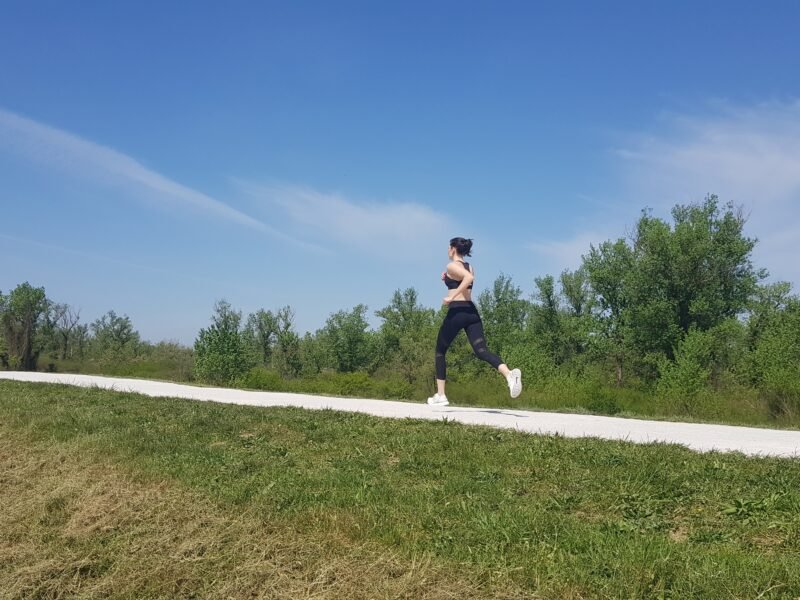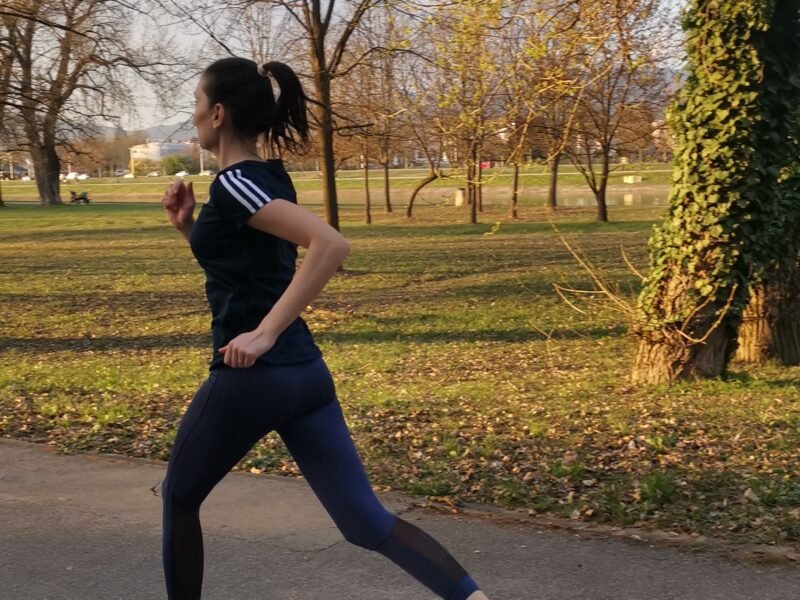What is Fartlek? (12 Creative Fartlek Training Examples)
Do you wish to break up the monotony of your training? To be faster?
Add fartlek to your training plan.
In this article, I will answer the most common questions about fartlek and give you 12 fartlek training examples. Let’s go!
What is fartlek training?
Fartlek is a type of training that consists of continuous running, alternating faster and slower segments. It is run according to feeling, and the pace varies from a completely easy run up to 80% of maximum speed. It is used by runners for improving speed and endurance.
The goal of fartlek training is to adapt the body to different running speeds.
Changing the pace and continuity, activate both the aerobic and anaerobic system.
Fartlek training is a moderate intensity workout and does not greatly exhaust the body.
Info
Fartlek is a term that is derived from a Swedish word which means “speed play”. It was designed by Swedish Olympian and coach Gustaf Richard Mikael Holmer in 1937, when he was coaching the Swedish cross country team.
In order to progress in training, diversity is important.
Over time, the body adapts to a certain type of exertion and you stop making progress, so your results stagnate.
For this reason, it is important to combine different types of training and exert your body in different ways.
As it means in translation, fartlek allows you to bring a game-like element to your training and break up the monotony of your everyday running.
Listen to your body, without the pressure of the running pace and a pulse meter, and just enjoy your run!

How to properly do fartlek training?
There are numerous variations of fartlek training and depending on what type it is, it only differs in the main part of training.
Fartlek training can be classic and structured.
Regardless of the type, fartlek training consists of warming up, continuously moving to the main part of training, and at the very end cooling down.
It is done without stopping with the recovery of a slower run. It is important to adjust the pace to your own feelings and current fitness level.
Fartlek training gives your body a chance to get used to a faster running pace without too much stress.
No matter which variation of fartlek it is, fartlek training consists of:
1. Warm-up
2. The main part of training – in continuity move to the main part of training, alternates between faster running and active recovery (continue running at a slower pace, without stopping)
3. Cool down
What is the difference between classic and structured fartlek?
Classic fartlek is a type of fartlek training that has no structure or rules to follow. It is based on feeling and inspiration, which makes it an excellent introduction and preparation for interval training. There are numerous variations of classic fartlek training. Be creative and play with speed.
Structured fartlek is a type of fartlek training in which the duration or distance of fast and slow intervals is predetermined, while you adjust the running pace to your own feelings and possibilities.

What are fartlek training examples? (12 fartlek workouts)
In the following text, I will show you 12 fartlek training examples.
1. Fartlek by feeling
Fartlek by feeling is a type of classic fartlek training that has no structure or rules that you have to follow, it is based on feeling and inspiration.
After the warm-up, insert alternately faster and slower running segments.
Run at a faster pace until you feel tired. When you feel tired, slow down.
After you recover, speed up again and keep alternating your pace.
The distance does not matter, nor does the pace and running intensity. All that matters is that you listen to your body and run according to your feeling.
Example of fartlek by feeling
1. Warm-up
2. Main part of training
– Speed up to the desired pace
– When you feel tired, slow down
– After you have recovered, speed up to the desired pace
– Continue by alternating between faster and slower running
3. Cool down
2. Landmark fartlek
Landmark fartlek is a type of classic fartlek training in which you change the running pace by orienting yourself with a marker on the road, park, or forest.
It can be street lights, signs, poles, trees, etc.
Example of landmark fartlek
1. Warm-up
2. Main part of training – continue alternating faster and slower running, orienting yourself with the help of street lights
3. Cool down
3. Music fartlek
Music fartlek is a type of classic fartlek training in which you change the running pace of each song or according to different parts of the song (e.g. speed up when the chorus of the song comes and run the other parts at an easier pace).
This is a great workout for anyone who likes to listen to music when running.
Example of music fartlek
1. Warm-up – 2 songs
2. Main part of the training – 6 songs (run the chorus of each song at a faster pace than the other parts of the song)
3. Cool down – 2 songs
4. Buddy fartlek
Buddy fartlek is a type of classic fartlek training in which one of you determines the pace and the other determines the distance of faster and slower segments.
But be careful with this type of training! It is important that you and your partner are at a similar level of form to avoid overexertion or injury.

5. Short fartlek (time-based)
Short fartlek (time-based) is a type of structured fartlek training that includes 1 to 3 minutes of fast running with 30 seconds to 2 minutes of active recovery (easy jogging).
Example of short fartlek (time-based) – 40 minutes
1. Warm-up – 10 minutes of easy jogging
2. Main part of training – 20 minutes of running (1 minute of faster running / 1 minute of slower running) x 10
3. Cool down – 10 minutes of easy jogging
6. Short fartlek (distance-based)
Short fartlek (distance-based) is a type of structured fartlek training that includes 100m to 500m of faster running with 50m to 400m of active recovery.
This type of training is preferable to do on a running track as the intervals are short and it is easier to follow the training without looking at the watch.
Example of short fartlek (distance-based) – 8 km
1. Warm-up – 2 km of easy jogging
2. Main part of training – 4 km of running (200m of faster running / 200m of slower running) x 10
3. Cool down – 2 km of easy jogging
7. Long fartlek (time-based)
Long fartlek (time-based) is a type of structured fartlek training that includes a minimum of 3 minutes of faster running.
Active recovery should last at least half the time during a fast run.
For example, if you run fast for 4 minutes, active recovery should last at least 2 minutes.
Example of long fartlek (time-based) – 45 minutes
1. Warm-up – 10 minutes of easy jogging
2. Main part of training – 30 minutes of running (4 minutes of faster running / 2 minutes of slower running) x 5
3. Cool down – 5 minutes of easy jogging
8. Long fartlek (distance-based)
Long fartlek (distance-based) is a type of structured fartlek training that includes a minimum of 500m of faster running.
Active recovery should last at least half the distance during a fast run.
For example, if you run fast for 1 km, active recovery should last at least 500m.
Example of long fartlek (distance-based) – 11 km
1. Warm-up – 2 km of easy jogging
2. Main part of training – 7,5 km of running (1 km of faster running / 500m of slower running) x 5
3. Cool down – 1,5 km of easy jogging
9. Ladder fartlek (time-based)
Ladder fartlek (time-based) is a type of structured fartlek training in which the main part of the training has fixed time intervals that become progressively higher or lower.
Example of ladder fartlek (time-based) – 49 minutes
1. Warm-up – 10 minutes of easy jogging
2. Main part of training – 29 minutes of running
– 8 minutes of faster running / 4 minutes of slower running
– 6 minutes of faster running / 3 minutes of slower running
– 4 minutes of faster running / 2 minutes of slower running
– 2 minutes of faster running
3. Cool down – 10 minutes of easy jogging

10. Ladder fartlek (distance-based)
Ladder fartlek (distance-based) is a type of structured fartlek training in which the main part of the training has fixed distances that become progressively higher or lower.
Example of ladder fartlek – 8 km
1. Warm-up – 2 km of easy jogging
2. Main part of training – 4,2 km of running
– 1 km of faster running / 500m of slower running
– 800m of faster running / 400m of slower running
– 600m of faster running / 300m of slower running
– 400m of faster running / 200m of slower running
– 200m of faster running
3. Cool down – 1,8 km of easy jogging
11. Pyramid fartlek (time-based)
Pyramid fartlek (time-based) is a type of structured fartlek training in which the main part of the training has fixed time intervals that become progressively higher/lower and then vice versa.
Example of pyramid fartlek (time-based) – 46 minutes
1. Warm-up – 10 minutes of easy jogging
2. Main part of training – 26 minutes of running
– 2 minutes of faster running / 1 minutes of slower running
– 4 minutes of faster running / 2 minutes of slower running
– 6 minutes of faster running / 3 minutes of slower running
– 4 minutes of faster running / 2 minutes of slower running
– 2 minutes of faster running
3. Cool down – 10 minutes of easy jogging
12. Pyramid fartlek (distance-based)
Pyramid fartlek (distance-based) is a type of structured fartlek training in which the main part of the training has fixed distances that become progressively higher/lower and then vice versa.
Example of pyramid fartlek (distance-based) – 9 km
1. Warm-up – 2 km of easy jogging
2. Main part of training – 5 km of running
– 400m of faster running / 200m of slower running
– 800m of faster running / 400m of slower running
– 1200m of faster running / 600m of slower running
– 800m of faster running / 400m of slower running
– 400m of faster running
3. Cool down – 2 km of easy jogging
How to warm up for fartlek training?
Warm-up before fartlek training includes an easy jog for 5 to 15 minutes and then, in continuity, without stopping, you move on to the main part of the training, alternating between faster and slower intervals.
Adjust the duration of your warm-up according to your current fitness level. It is important to prepare your body for the main part of training but be careful not to get too exhausted.
Read more: Warm-up Before Running [Ultimate Guide]

How to know what pace to run in fartlek training?
Fartlek training is run according to your feeling, without keeping track of pace. When you are running, it does not matter how fast you are going, but how you feel. Listen to your body, relax, and enjoy.
If you are running with a watch, try not to bother yourself with your pace. Set yourself an option on the watch to tell you when to speed up and when to slow down.
Most importantly, enjoy and play with speed!
How long does fartlek training last?
On average, fartlek training lasts for 45 minutes. However, the duration should be adjusted according to your current fitness level and training goal.
If you aim to improve your endurance, you should do a long fartlek. If you wish to improve your speed and wake up your legs, then you should do a short fartlek.
When should runners do fartlek training?
Fartlek training can be used throughout the year because you can adjust it to any and every training goal.
One of the main benefits of fartlek is running according to your feeling, without concerning yourself with pace. You will not stress your body too much and it is not mentally challenging, which is why you can use it in any phase of your training.
During the base phase, fartlek allows you to progress from slower to faster running and is a great introduction to interval training.
In later phases, fartlek is also great as a break between more demanding workouts because you don’t have to bother with the running pace but follow your own feeling.
For example, it is less mentally exhausting to do 6 x 4 minutes than it is to run 6 x 1000 meters.
There is less stress when you run on time and feeling than when you have a given distance and running pace. But that doesn’t necessarily mean you’ll do a worse workout.
How often should runners do fartlek training?
Fartlek training should be done at least once a week. Depending on your fitness level and goals, you can do it multiple times a week.
This way you will break the monotony in your training and add speed without too much stress.
Who is fartlek training suitable for?
Fartlek training is intended for everyone, both beginners and more advanced runners.
Considering you run fartlek according to feeling, beginners should take care because they can be fooled by their own feeling. It very often happens that they start too fast at the beginning of training and fail to endure to the end.
What are the benefits of fartlek training?
Fartlek training has numerous benefits:
1. Improves endurance
2. Develops speed and strength
3. Burns up to three times as many calories as continuous running
4. Allows managing pace changes more easily during a race
5. Adaptable to your current fitness level; does not require pace tracking (it is run according to feeling)
6. Flexible – fartlek training can be difficult or easy, depending on your training plan and goals
7. Offers variety – by playing with speed and alternating pace you can make your training more fun
8. You can do it alone or in a group
The result of this study demonstrates that fartlek training has a significant influence on improving the maximum oxygen consumption and resting pulse rate, which directly leads to better endurance.
Another study showed that fartlek training has a significant impact on improving cardiorespiratory fitness and muscular endurance in young adults.

How does fartlek training improve speed?
Fartlek means “speed play”. As you listen to your body, you add faster segments to your continuous run.
By alternating pace, you allow your body to adapt to different speeds and thus improve your running speed over longer distances.
What is the difference between fartlek and interval training?
Fartlek and interval training are different in their structure and the way they determine the pace.
Fartlek is a less structured type of training during which you do not need a fixed distance, run duration, recovery time, or pace. You run according to your feeling, without concerning yourself with pace.
During interval training, you have a predetermined distance and pace of intervals and the duration of the break.
Can you do fartlek training on a treadmill?
Fartlek can also be done on a treadmill. The only downside is that a standard treadmill does not track your pace automatically, so you have to slow down or speed up by pressing buttons.
For this reason, I recommend a longer duration of faster and slower segments, fewer pace changes, to having as little contact with the control panel as possible.

Matea Matošević
Hi, I’m Matea! I’m an Olympic Marathon Runner, founder, and writer behind OLYRUN.com. On this site, I provide help in the form of my knowledge and experience to all who love running and active living. Read more…

